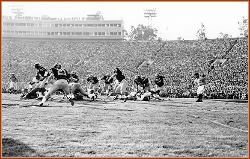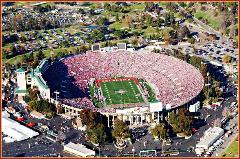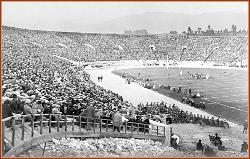



The Melbourne Cricket Ground (MCG) is an Australian sports stadium located in Yarra
Park in inner Melbourne, home to the Melbourne Cricket Club. It holds the world record
for the highest light towers at any sporting venue. The MCG is within walking distance of
the city centre, and is serviced by Richmond and Jolimont train stations.
Internationally, the MCG is remembered as the centrepiece stadium of the 1956 Summer
Olympics and the 2006 Commonwealth Games. The open-air stadium is also one of the
world's most famous cricket venues, with the well-attended Boxing Day test match
commencing on Boxing Day every year. Throughout the winter, it serves as the home of
Australian rules football, with at least one game (though usually more) held there each
round. In late September, the AFL Grand Final fills the stadium to capacity.
Until the 1970s, more than 120,000 people were sometimes crammed into the venue - the
record crowd standing at around 130,000 for a Billy Graham religious event in 1959,
followed by 121,696 for the 1970 VFL Grand Final. Renovations and safety regulations
now limit the maximum capacity to just under 100,000.
The MCG, often referred to as "The G", has also hosted other major events, including
International Rules between the Australian Football League and Gaelic Athletic
Association, international Rugby union, State of Origin rugby league, football (soccer)
World Cup qualifiers, and large rock concerts. When Madonna performed at the ground
during her Girlie Show Tour in 1993, she dubbed it "The G Spot".
During the lunch break at the 2005 Boxing Day Cricket Test, it was announced by
Australian Federal Treasurer, Peter Costello, that the MCG would be added to the
Australian Heritage Register. Punt Road Oval, home of Richmond Football Club is located
only a few hundred metres to the east of the famous Melbourne Cricket Ground.
Early History
On the September 23, 1853, occupancy of the present site, which was part of a 'police
paddock', was given to the Melbourne Cricket Club by Lieutenant Governor Charles La
Trobe. This followed the forced resumption of land from the then-15-year-old Club to
build Australia's first steam train railway.[1] The First Members' Pavilion was erected the
following year, and the first cricket match was played on September 30, 1854.
The first intercolonial cricket match to be played at the MCG was between New South
Wales and Victoria on March 26 and 27, 1856.[2] That match was also notable for a
dispute which arose after the umpires had tossed and which Victoria had won. The New
South Wales players insisted that, as the visiting team, they had the choice of batting or
bowling. Victoria eventually relented and were sent in. New South Wales won the match
by three wickets.
The first Australian rules football match was played on the MCG on July 12, 1859,
between Melbourne Football Club and South Yarra. In 1862 a visiting Surrey XI,
captained by HH Stephenson, played a World XI there, beginning on New Year's Day.
On Boxing Day 1866 an Indigenous Australian cricket team played at the MCG with
11,000 spectators against an MCC team. That team went on to tour England in 1868 and
played at the ground three more times before 1869.
The MCG was one of the venues for the first bicycle race in Victoria, in July 1869.
In 1985 light towers were installed at the ground, allowing for night football and day-night
cricket games.
The Great Southern Stand was erected in 1992 as part of a major redevelopment for the
1992 Cricket World Cup. In doing so, more than one half of the MCG was rebuilt. The new
stand was built at a cost of AUD$150 million and for a capacity of 48,000.
The 1928 Members' stand, as well as the 1956 Olympic stand and the 1968 Ponsford
stand were demolished in late 2002. They were replaced with a new structure in time for
Melbourne to host the 2006 Commonwealth Games. Despite now standing as a single
unbroken stand, the individual sections retain the names of Ponsford, Olympic and
Members Stands. The redevelopments total cost exceeded AUD$400 million and pushed
the grounds capacity over the 100,000 mark (when standing room is taken into account).
Since redevelopment, the highest attendance was the 2006 AFL Grand Final with 97,431.
Soccer Info
On February 9, 2006, Victorian premier Steve Bracks and Football Federation Australia
chairman Frank Lowy announced that the MCG would host a world class event each year
from 2006 until 2009 inclusive. It comes as the game is gaining popularity in the country
following the qualification for the 2006 FIFA World Cup in Germany
The agreement sees an annual fixture at the MCG, beginning with a clash between
Australia and European champions Greece on May 25, 2006 in front of a sell-out crowd
of 95,103, before the Socceroos left to contest in the World Cup finals. The Socceroos
will also host a match in 2007 against Argentina, a FIFA World Cup qualifier in 2008, and
another in 2009 which could possibly decide Australia's participation in the 2010 FIFA
World Cup in South Africa.
Other matches played at the MCG include the following:
- A 1998 FIFA World Cup qualifier between the Socceroos and Iran on Saturday 29
November 1997. The match was drawn 2-2, with Iran progressing on the away goal
rule.
- An exhibition match between Manchester United and the Socceroos on 15 July
1999.
- A friendly match between Brazil B and the Socceroos on 17 November 1999.
- An Olympic Tournament group match between Italy and the Olyroos on 13
September 2000.
- A 2002 FIFA World Cup qualifier between the Socceroos and Uruguay on Tuesday
20 November 2001. The Socceroos won 1-0, however Uruguay progressed after
later winning the second leg 3-0.














